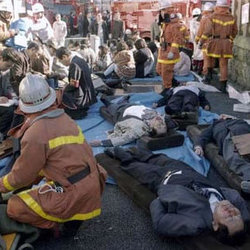Post-bubble Japanese society is characterized by the naturalization of shock. 20th century Japanese history is filled with shocking events, from the atomic bombs at the end of World War Two to terrorist incidents in the 1970s. After the bubble economy collapsed at the beginning of the 1990s, social pessimism reached new heights, peaking with the Aum Shinrikyo sarin gas attack (pictured at right) on the Tokyo subway system in 1995. Japanese society has become accustomed to shocks, and shock has been replaced by a search for new identity.
Post-bubble culture, which is developing through the generation that matured in the 1990s and subsequent generations, develops through the various methods young Japanese employ in their search for this new identity: materialism, minimalism, obsession with the past or the future, withdrawal or escapism, and an overarching nihilism. These responses are expressed by the post-bubble youth directly through a surge in youth literature, including acclaimed novelists Kanehara Hitomi and Wataya Risa. In particular, Kanehara’s works have been touted as “shocking,” but largely have failed to actually shock post-bubble Japan.
